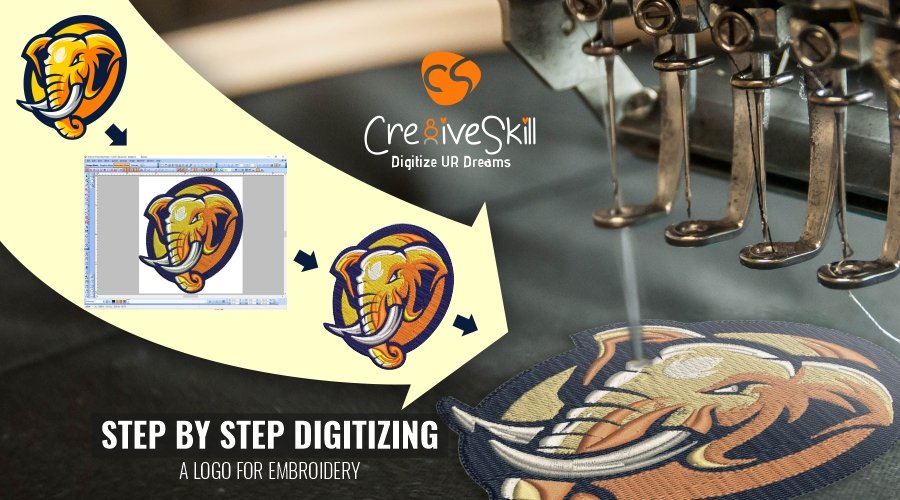Trustworthy Digitizing for Embroidery: Relied On by Experts
Trustworthy Digitizing for Embroidery: Relied On by Experts
Blog Article
Understanding the Embroidery Digitizing Refine: Your Ultimate Guide
Needlework digitizing is a careful craft that requires accuracy and know-how to translate elaborate layouts right into digital styles for equipment needlework. As artisans begin on this trip to master the embroidery digitizing procedure, a thorough understanding of the basics sets the foundation for quality. Nonetheless, beyond the simple expertise lies a realm of advanced software program, specialized devices, and nuanced strategies waiting to be explored. By diving right into the subtleties of digitizing, one can open a globe of imaginative opportunities and boost their needlework tasks to brand-new elevations.

Comprehending Embroidery Digitizing Fundamentals
Embroidery digitizing basics form the foundation upon which elaborate styles are translated into machine-readable formats for precise stitching. This initial action in the needlework digitizing procedure is important for making certain that the last stitched item is a loyal depiction of the initial style. Comprehending needlework digitizing fundamentals entails realizing vital principles such as stitch types, sew direction, density, rug, and draw compensation.
Sew kinds play an important role in establishing the aesthetic and textural result of the embroidered style. By picking the suitable stitch type, whether it be satin, fill, or running stitch, digitizers can accomplish the desired effect and enhance the total high quality of the embroidery. Furthermore, sew instructions influences the flow and dimension of the layout, while thickness establishes the spacing and insurance coverage of the stitches.
Additionally, padding stitching provides security to the design by protecting the textile and avoiding distortion throughout the needlework process. Pull payment is one more important consideration to counteract the all-natural tendency of material to contract when sewn. Mastering these embroidery digitizing fundamentals is basic for producing professional-quality embroidered products.
Picking the Right Digitizing Software
Selecting the proper digitizing software is a vital choice that substantially affects the effectiveness and quality of the needlework digitizing process. Digitizing for Embroidery. When selecting the appropriate digitizing software, it is necessary to consider factors such as the complexity of layouts you intend to create, the user-friendliness of the software, the level of client assistance supplied, and the compatibility with your needlework equipment
There are numerous digitizing software application choices offered in the marketplace, varying from basic programs for beginners to advanced software for professional digitizers. Some popular selections consist of Wilcom EmbroideryStudio, Hatch Needlework Software Program, and PulseID. These software program packages supply a broad array of devices and attributes to aid you develop detailed layouts effortlessly.
Before making a decision, it is a good idea to check out the different software application options via cost-free tests or demonstrations to identify which one best matches your requirements. Additionally, reviewing testimonials and looking for suggestions from experienced digitizers can provide important insights right into the staminas and weaknesses of each software (Digitizing for Embroidery). By carefully evaluating your needs and contrasting the features of various digitizing software application, you can make an informed option that boosts your needlework digitizing operations
Digitizing Tools and Strategies

Optimizing Layout Setup for Needlework
Grasping the ins and outs of style settings is fundamental in achieving optimal lead to the embroidery digitizing process, structure upon the structure laid by comprehending digitizing tools and strategies. When maximizing style settings for embroidery, it is vital to consider factors such as stitch kind, thickness, rug, pull compensation, and registration. Stitch kind option affects the total feel and look of the design, with alternatives like satin, fill, and running stitches using different textures and results. Density refers to the spacing and density of stitches, influencing the layout's protection and sturdiness. Proper rug stitching gives stability and prevents textile distortion, particularly for complex layouts or on stretchy products. Pull payment readjusts for material click here for more info stretch throughout stitching, guaranteeing exact design duplication. Registration setups align various elements of the style accurately, keeping overall layout honesty. By fine-tuning these layout settings, embroiderers can boost the high quality and accuracy of their stitched productions.

Troubleshooting Common Digitizing Issues
When experiencing usual digitizing issues throughout the needlework process, it is vital to comprehend the origin causes and carry out effective solutions immediately. One usual problem is stitch density concerns, where stitches might be too thick, creating the fabric to pucker, or as well sparse, resulting in spaces in the layout. Adjusting the stitch density settings in the digitizing software application can aid settle this issue.
Another regular obstacle is string breaks throughout the embroidery procedure. This can happen as a result of numerous reasons such as incorrect tension setups, boring needles, or using low-quality thread. Making certain correct upkeep of the needlework device, including routine needle modifications and stress changes, can minimize the occurrence of thread breaks.
Furthermore, style registration errors can result in misaligned elements within the embroidery design. Checking the design alignment in the digitizing software and making required adjustments before stitching can aid in preventing this concern. By resolving these usual digitizing problems immediately and properly, you can make certain a smoother needlework procedure and high-quality ended up items.
Final Thought
To conclude, grasping the embroidery digitizing procedure calls for a solid understanding of the basics, the right selection of software program, and understanding of tools and techniques. Maximizing style settings and repairing usual digitizing problems are important action her latest blog in ensuring high-grade needlework results. By adhering to these actions vigilantly, one can achieve accuracy and efficiency in the digitizing process.
Report this page